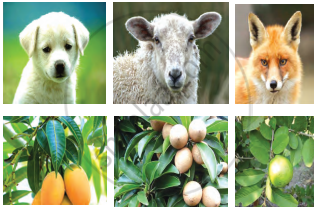Advertisements
Advertisements
Question
Give a scientific reason.
Morphological evidences suggest that dog, sheep and wolf have a common origin.
Solution
The similarities between dog, sheep, and wolves' jaw structures, eye positions, nare structures, and other anatomical features show that these three animals share a common ancestor.
APPEARS IN
RELATED QUESTIONS
Mammals : _________ : : Amphibia : Fishes
Explain with an example for the given, how the following provides evidence in favor of evolution in organisms :
Homologous organs
Given below is the list of vegetables available in the market. Select from these the two vegetables having homologous structures:
Potato, sweet potato, ginger, radish, tomato, carrot, okra (Lady’s finger)
(A) Potato and sweet potato
(B) Radish and carrot
(C) Okra and sweet potato
(D) Potato and tomato
Four students A, B, C and D reported the following set of organs to be homologous. Who is correct ?
(A) Wings of a bat and a butterfly
(B) Wings of a pigeon and a bat
(C) Wings of a pigeon and a butterfly
(D) Forelimbs of cow, a duck and a lizard
Explain the terms analogous and homologous organs with examples.
Explain the evolution of giraffe's neck according to Lamarck's theory of evolution.
Human tailbone is a vestigial organ. Explain.
Name two animals having homologous organs and two having analogous organs. Name these organs.
Out of bacteria, spider, fish and chimpanzee, which organism has a better body design in evolutionary terms? Give reason for your answer.
The organs which perform different functions but have the same basic structure are known as :
(a) homologous organs
(b) analogous organs
(c) homolytic organs
(d) analytic organs
There are five animals A, B, C, D and E. The animal A uses its modified forelimbs for flying. The animal B uses its forelimbs for running whereas the animal C uses its forelimbs for grasping. The animal D can live on land as well as in water and uses its forelimbs to prop up the front end of its body when at rest. The animal E which respires by using spiracles and tracheae uses wings for flying but its wings are analogous to the modified forelimbs of animal A.
(a) What could the animals A, B, C, D and E be?
(b) Why are the forelimbs of animals A, B, C, D called homologous organs?
(c) What does the existence of homologous organs in animals A, B, C and D tell us about their ancestors ?
(d) Why are the modified forelimbs of animal A and the wings of animal E called analogous organs?
(e) State whether animals A and E have a common ancestor or not.
The organs P and Q of two animals have different structures but similar functions. On the other hand, the two organs R and S of two other animals have the same basic structure but different functions.
(a) What are the organs like P and Q known as?
(b) Name the organs like P and Q. Also name the animals which have such organs.
(c) What are the organs like R and S called?
(d) Name the organs like R and S. Also name the animals which have such organs.
Select a set of homologous organs from the following:
(A) Wings of a bat and wings of a butterfly
(B) Wings of a pigeon and wings of a bat
(C) Wings of a butterfly and wings of a pigeon
(D) Forelimbs of a duck, forelimbs of a cow and forelimbs of a lizard
In a class, students were asked to observe the models/slides/pictures of the skeletons of forelimbs and wings of different organisms. After the observations the students made the following groups of homologous structures. Select the correct group :
(A) Wings of a bird and a butterfly
(B) Wings of a pigeon and a bat
(C) Wings of a butterfly and a bat
(D) Forelimbs of a cow, a duck and a lizard
Read the following statement and justify same in your own words with the help of suitable example.
There is evidences of fatal science among chordates.
Explain with suitable examples importance of anatomical evidence in evolution.
Define fossil.
Find an odd one out.
Name the parts shown in the diagram.
Human jaw

Match the following.
| Column A | Column B |
| 1) Morphological evidences | a) Tail-bone or wisdom teeth |
| 2) Paleontological evidences | b) Leaf venation |
| c) Fossils |
Observe the given images and answer the following questions.

- Which evolutionary evidence does it indicate?
- What does it prove?
- State another example of evolutionary evidence.
Homologous organs and vestigial organs are examples of ______ type of evidence in evolution.
Select the CORRECT set of homologous organs.
Where is carbon dating used?
Homologous organs are:
Cucurbits do not develop thick and woody stem as they are:
Palaeontological evidence for evolution refers to the ______.
Evolutionary convergence is the development of:
The presence of gill slits, in the embryos of all vertebrates, supports the theory of ______.
Which is not a vestigial organ in a man?
Flippers of Penguins and Dolphins are examples of:
The study of fossil evidence of evolution is called ______
What are we referring to? When we say 'simple organisms' or 'complex organisms'.
Give an example for convergent evolution and identify the features towards which they are converging.
The evolutionary story of moths in England during industrialisation reveals, that 'evolution is apparently reversible'. Clarify this statement.
Complete the following chart:

What is the function of the appendix of our digestive system?
